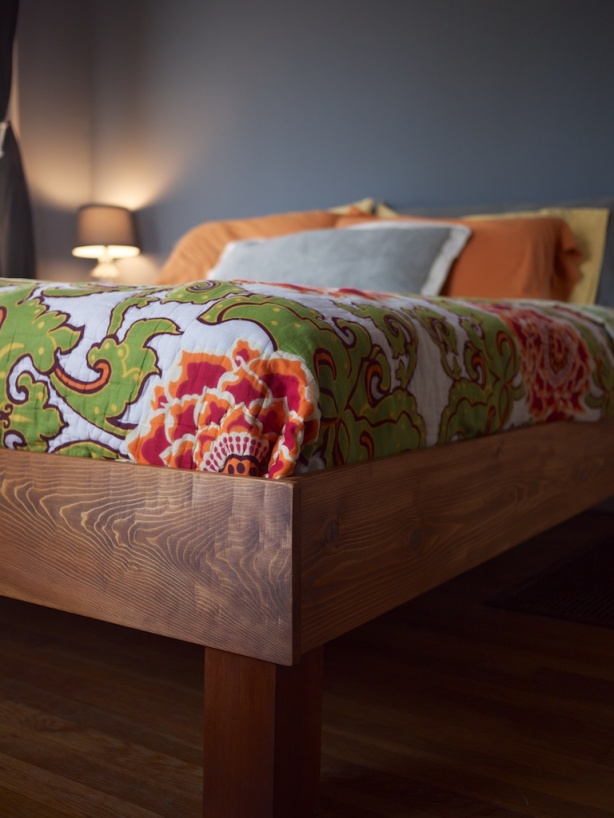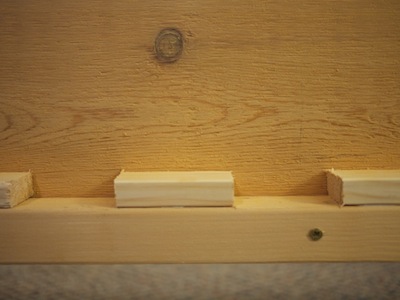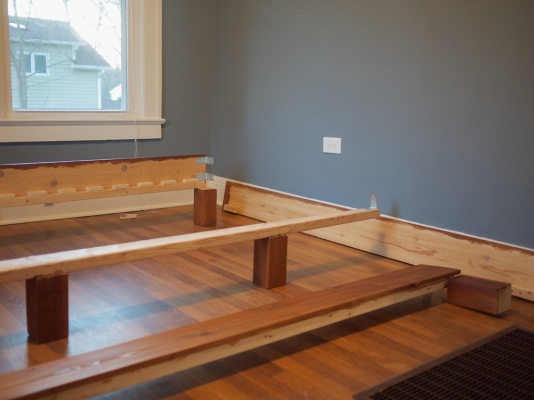The Kiwi is here today to tell y’all all about the time we decided to build our own king-size bed. In our search for the perfect bed, I fell in love with West Elm’s Boerum Bed Frame. Unfortunately, it was a bit out of our budget. So, being the hero he is, The Kiwi sketched up some plans and a few trips to the hardware store later, I’m writing this on my very own Boerum-style bed for a third of the cost!
When we moved from Germany to the U.S. at the end of last year, we were fortunate that Lauren already owned a car and a houselot of furniture here. That left a bed as our one major essential purchase—I am considerably taller than a double (or, as they’re quaintly called in America, ‘full’) bed is long, and after Germany’s king-size-as-standard that was not going to cut it.
One thing I was already sure about is that I wanted a slat bed. This is what I had back in New Zealand (with an inner-spring mattress), and both of the beds that we had in Germany (with high-density foam mattresses). Slat beds are, as far as I can tell, better in every way than box-spring bases. Unlike box springs, they don’t wear out and are not ugly. They’re also a lot lower-profile, so for the same height of bed you get a lot more space to stock up on toilet paper, whiskey, and other fungible goods to barter with in the event of the collapse of the global monetary system (as one of our friends in Germany does), or just for your crazy dog who likes to lie under things, even if it means occasionally getting stuck and needing rescue at 3am. For instance.
Slat beds are ubiquitous in Europe, and becoming increasingly popular in New Zealand. In America, however, they remains somewhat unusual. As evidence of this, search for them on the Internet and you’re bound to find at least one person recommending that you just slip a sheet of plywood under your mattress and get all the benefits of a slat bed, with a bunch of replies from people saying that worked great for them. Do NOT put plywood under your mattress. Mattresses need to breathe, and if you don’t give them a chance you’ll start growing the sort of mould that at best might start producing neurotoxins that put you afoul of international chemical weapons treaties, and at worst could spontaneously self-organise into some sort of Lovecraftian horror. Just say no, for Cthulhu’s sake.
Naturally our first thought was to simply buy a bed. Research revealed that our options were limited to a nice-ish wooden bed from for around $450, or an Ikea laminate monstrosity for more like $275. After lengthy consideration, we decided to bite the bullet and get the nicer one. Then we discovered that the $50 Internet ‘delivery’ charge applied even if you picked up the bed from the store rather than get it delivered. Once we started going through the checkout process online, it transpired there was another $50 delivery charge to get it delivered to where we actually were, since the store didn’t have any in stock that you could pick up there anyway. We probably should have remembered that it’s perfectly normal here to advertise prices that don’t include the tax you have to pay, but having spent all but one year of my life in countries where it is most definitely illegal, I hadn’t. Neither had Lauren—we can both testify to how easy it is to forget how your own country works in only a couple of years. Now more than 30% over our already-stretched budget, we balked, abandoned the Kafkaesque website checkout and its misleading pricing and headed for the hardware store to size up our options. How hard could it be to build a bed?
The result cost about half as much as the Ikea option in materials (the $150 figure, by the way, includes sales tax), probably still worked out cheaper than the solid wood bed even if you attached a significant cost to our time, and looks better than either if I may say so myself. I’d estimate that we put about three half-days of work into it in the lead-up to Christmas. (Unless your body is used to this particular kind of physical work—in which case you probably don’t need this post—I would not recommend trying to force a shorter schedule.) This blog is mostly about food, but today you get a recipe for a bed that you should be able to repeat yourself, without the hassle of trying to design it yourself or the 3 return trips to the hardware store as it changed over time.

King Size Slat Bed
Timber:
|
Lengthwise |
Crosswise |
Vertical |
| 4″ × 4″ Cedar |
|
|
6 × 8″ |
| 8″ × 0.75″ Cedar |
2 × 80″ |
2 × 78½” |
|
| 3″ × 1″ |
|
15 × 75″ |
|
| 2″ × 2″ |
2 × 77″ |
|
|
| 4″ × 2″ |
1 × 80″ |
|
|
| 2″ × 1″ |
28 × 3″ |
|
|
Note that the dimensions given for wood are always the rough-sawn sizes. You want to buy dressed timber, so while these are the sizes you’ll see labeled, if you measure them you’ll find they’re considerably smaller. Use only untreated timber, and make sure you select pieces without any noticeable kinks or twists, which can make your life a living hell. The hardware store will likely be able to cut everything to length for you for free, but they’ll mostly likely not be able to rip anything down to a smaller size, so make sure you find material with the dimensions you want. Hang on to the offcuts, there will be uses for those too.
Fasteners:
- 8 Corner brackets
- 60 ⅝” wood screws
- 50 2″ #8 wood screws
- 12 3″ #10 wood screws
- Wood glue (e.g. Liquid Nails)
Tools:
- handsaw
- electric drill,
- spirit level
- square
- caulking gun
- sandpaper
- vise (optional but very handy for the sanding and sawing)
Your first, and perhaps most arduous, task is to sand down all of the external parts of the bed. This is essential for a smooth finish, as even dressed boards will have tool marks, rough patches and grain in relief (and the grain will be brought out even more when you stain it). My obsession with sanding has earned me a reputation that will take years to live down, but it’s worth it. Sand thoroughly first with a medium-coarse ~120 grit paper, then remove the artifacts left by that using a fine 220 grit paper.
In our case, the cedar planks were dressed only on one side, and that was fine—we just used that side as the outside. Don’t bother giving the inside anything more than a quick once-over, except for a couple of inches at either end of the head and foot boards, which will overlap the side boards and be visible. The legs were not dressed at all, and thus required the most work (the vise was handy at this point—use a couple of the offcuts from the slats to avoid damaging the timber in the jaws). Don’t forget about the ends—sand some 45° chamfers first to avoid splits, since it’s practically impossible to work with the grain on the end grain. Round off all the edges and corners as you go, because they’ll be the things attacking your shins and toes in the dead of night for the rest of your life.
You could stain the wood at this point, but there’s a risk of damage as you continue to build the bed. In most cases you’ll be building the bed in a different room to the one where you want it, so you’ll have to disassemble it at some point anyway and that is the best time to stain. In our case those rooms were about 250 miles apart, but even if they’re as close as your bedroom and your garage, that won’t help you get a King-size bed through the door.
The two 2″ × 2″ rails are going to sit on the legs and bear the main weight of the bed. Begin by screwing them (with the 2″ screws) to the insides of the two side (i.e. lengthwise) planks, flush with the bottom edge and equidistant from each end. About 5 screws in each should be plenty to hold them. (Edit: It turns out that there is considerable force transfer from the rails to the sides, Cedar is a pretty soft wood, and the sides don’t offer a lot of depth for the screws to bite. To avoid developing future squeaks, more screws are better and glue is recommended too.) Put at least 20 or so screws in each side. If you favour the belt-and-braces approach you can glue them first as well. We didn’t because we were making it up as we went along and not sure that we would get it 100% right first time. Cut the offcuts into four ~4″ sections and fix them to the head and foot planks around 3″ from the ends. These allow you to stand those boards upright while you work, and give you something to screw to the legs later.
The corners use an overlapping joint design, because that is the easiest thing to get looking good with minimal carpentry skill. The nicest-looking joints are of course the dovetail or mortice and tenon, but those require enormous amounts of skill (and equipment) to get right. A simple butt joint has to line up exactly to avoid looking badly made, whereas an obviously-intentional overlap hides a multitude of sins.

Assemble the four cedar planks into a bed shape, with the head and foot boards protruding beyond the sides. The interior width of the bed should be 76″. Using the square and level, square up the corners and screw two angle brackets into each one. This is, of course, much harder than it sounds. It pays not to completely tighten the screws until you have worked your way around all four corners. Place the center rail down the centre and attach it to the head and foot boards with an angle bracket at each end too.


Now lift the whole thing up and place a leg under each corner (invite your friends!), and the remaining two legs under the centre rail, about a third of the way in or wherever you like. Make sure everything is level again, then screw the two side rails and the centre rail into the legs using the long screws. These ones will need to be pre-drilled. Don’t screw the short sections of rail on the head and foot boards into the legs yet, since you’re just about to have to take it all apart anyway. Use two screws for each of the legs on the centre rail. It pays to do all of this on a flat surface, but once of the great things about wood as a material is that if you get it close enough, it will adjust to the correct shape under its own weight. Don’t work on a hard surface like concrete, though, because you’re likely to damage the finish. Some old carpet without underlay is ideal.
Arrange your slats across the bed. It looks like a bed! Take your 3″ sections of 2″×1″ and place them along the rails between the slats to space them, then carefully remove the slats and mark the positions of the spacers with a pencil. I just cut these with a handsaw, because it seemed cruel to ask the hardware store guy to do so many. If I hadn’t been feeling lazy at the time, I would have cleaned up the edges with some coarse sandpaper. Glue the spacers to the rails. We used Liquid Nails. Before the glue dries, put the slats back and make sure they all still fit. Adjust as necessary. Then remove them again so you don’t accidentally glue them down.


It’s time to stain the bed. The exact colour was a cause of heated debate between us. Lauren want it really dark so as to hide the beautiful grain and colour of the wood and make it look like the fake-mahogany-but-actually-obviously-MDF furniture you see in every American furniture store. Whereas I wanted to use a light touch, more like the light pine furniture and floors and ceilings and walls that we were so thoroughly sick of in Germany. We both reluctantly compromised on Varathane’s ‘Provincial’ (beware: these names are in no way, shape or form standardised across stain producers), but as soon as we saw it we both agreed that the colour was completely perfect after one coat. Ideally you’d want to get to perfect after two coats, but we weren’t going to risk it.
Disassemble the bed by removing the two ends. Leave the legs attached to the sides. Then apply the stain to all of the cedar parts. Don’t bother about the inside other than the top couple of inches, because the unfinished surface will really drink up the stain (which can possibly lead to warping). You’ll probably want to let it dry for a day or so between coats, and for a couple of days after the second coat before using it. We used those disposable foam brushes and they were great, despite the tendency of the handles to come apart.

You’re basically done. Reassemble the bed in the room you actually want it in. If you’re transporting it first, be sure to wrap everything in blankets to avoid damaging the finish. With all the screw-holes already made, it should be a quick matter to reattach all the brackets. Real beds use a two-part bracket arrangement to make this step a little easier, where each part screws in to one side and then the two bolt together. I don’t know where to find those here though, so the angle brackets did the trick. Pre-drill and then screw in the short rail offcuts on the ends to the legs.

You’ll probably want to either varnish the surface with polyurethane or wax it to seal it at some point (give the stain a good few days to dry first though). We haven’t done ours yet, but will at some point in the next month or so when our bookcase arrives.
Replace the slats. Just to add a little stiffness, screw down the first, last and centre slats to the rails on each side. Since this will necessarily be very close to the ends, pre-drill the holes to avoid splitting the slats.
That’s it! You have a bed! Just drop in a mattress and you are good to go. Be aware when you’re shopping that a mattress sitting on a slat bed will be somewhat firmer than when it is on a box spring, so take that into account. We got a lot better deal—read, half the price—from a local country furniture store than at any of the five franchises of a single national chain that are inexplicably clustered on a half-mile stretch of the same road here.
The end result is beautiful, functional, and can offer the satisfaction of going to sleep every night knowing that you built it yourself. Enjoy!

A few notes:
The bed that really stretches the limits of material strength is not the king, but the queen. A king-size bed is so wide that you have no choice but to include a centre rail with its own legs, reducing it to the equivalent of two king singles in terms of weight distribution. So if you try to scale this bed down you can remove the centre rail, but not without increasing the strength of the slats. (I would use 4″×2″/100×50mm slats for a queen size bed.)
We have vague plans to build our own headboard some day that will attach inside the bed. If you want to do the same, add a couple of inches to the lengths of all the lengthwise members.
Just a few more weeks to sign up for our meal planning service, The Seasonal Supper! Our first collections roll out on June 1st, and I know you don’t want to miss out on a single day of fresh, seasonal recipes and loads of meal planning tools. At just $19.99 a season for four weeks of recipes, meal line-ups, grocery lists, calendars as well as blank tools that you can tweak to make work for you and your life, it’s a steal!
























 We ate this Malted Chocolate Pecan Pie without a second thought, because we made it from scratch
We ate this Malted Chocolate Pecan Pie without a second thought, because we made it from scratch